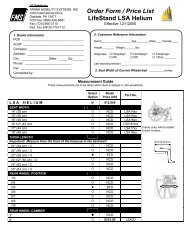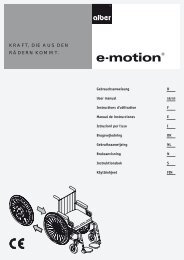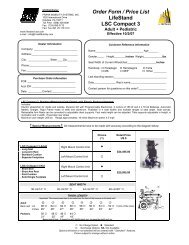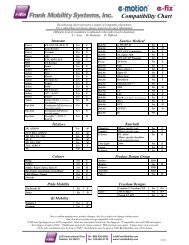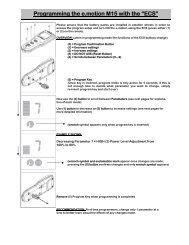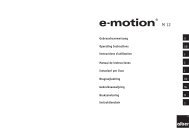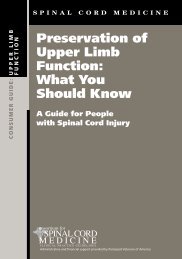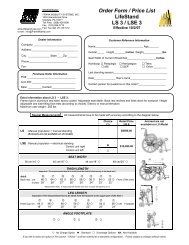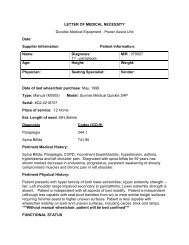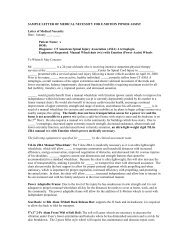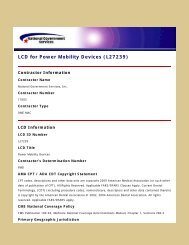Sample letter of medical necessity - Frank Mobility Systems
Sample letter of medical necessity - Frank Mobility Systems
Sample letter of medical necessity - Frank Mobility Systems
Create successful ePaper yourself
Turn your PDF publications into a flip-book with our unique Google optimized e-Paper software.
SAMPLE LETTER OF MEDICAL NECESSITYDurable Medical Equipment RequestK0005 manual wheelchair with E0986 Power AssistName: Diagnosis: M/RAge: Height: Weight:Physician: Seating Specialist: Vendor:Date <strong>of</strong> last wheelchair purchase: 2008Make: Invacare Model: TX-SP Serial: (#08GE005268)Place <strong>of</strong> service: HomeEst. Length <strong>of</strong> need: 99-LifetimeDiagnosis Codes (ICD-9) TypeQuadriplegia 344.00Skin disturbancePertinent Medical History: Sustained C4-C% Quadriplegia as a result <strong>of</strong> motor vehicleaccident – 8/9/07; s/p spinal stabilization surgery; existing grade 2 sore on spine; Hx <strong>of</strong>sacral decubiti ; s/p urinary tract infection; left shoulder has 3 pins;Pertinent Physical History:Patient presents gross hypo tonicity <strong>of</strong> both upper/lower extremities secondary toquadriplegia. Patient has a moderate correctible posterior pelvic tilt, moderate kyphosiswith depressed shoulders, which in the upright position, places significant pressureloading on buttocks, scapulae, sacrum and tailbone. Noted moderate hip, knee, andankle range limitations. Patient has severe upper extremity weakness and strength –patient has minimal active movement <strong>of</strong> right upper extremity to operate right mountedjoystick; Patient has limited functional movement <strong>of</strong> left upper extremity. Noted severelimitations to right upper extremity with poor (-) upper extremity strength and ½ range.Patient has impaired sensation below cervical injury level to feet. Patient presents withpoor head control. Patient is non-ambulatory, requires 1-2 personal carry transfers andpositional changes, and requires total external support to safely maintain posture.Patient is dependent upon caregivers and cannot reposition body, which places him atgreat risk <strong>of</strong> skin breakdown and back discomfort.***Without power wheelchair, patient would be bed confined.***
FUNCTIONAL STATUSSitting Balance: Poor – dependent on external supportUpper Ext. Function: Poor – severe upper extremity weaknessTransfers: 2 person carry transfersW/C <strong>Mobility</strong>: Unable to functionally operate manual wheelchair – Patient will be bedconfined without power wheelchair.Daily W/C Use: 12 hours +Ambulation: Non-AmbulatoryADL: moderate – maximum personal assistanceTransport: VanLiving environment: accessible home private homeCurrent Equipment: owns no equipmentClinical and Home MOBILITY TRIAL:Patient had successful trial with recommended power assist manual wheelchair duringclinical trials at _____ ______ Hospital. DME supplier performed home accessibilitytrial with patient to all essential areas and deemed accessible.The following recommendation <strong>of</strong> durable <strong>medical</strong> equipment is found to be the mostcost effective system to meet this patient’s postural support and mobility needs and it ismade with recognition <strong>of</strong> this patient’s potential for growth and/or change.
PRESCRIBED MANUAL MOBILITY and SEATING SYSTEM:Tilite Aero R-K005 (16wx16d) Power Adaptable Frame with Emotion M15 PowerAssist Push Rims and Handrim Rubber covers (light weight, rigid frame that iseasy for patient to propel with both upper extremities; more responsive turning, andeasier to transport in/out <strong>of</strong> vehicle; Reinforced framed required to support Emotionwheels; short frame depth and seat width required to accommodate proper leglength and hip width; short frame height requests for easy transfers secondary tolower extremity length and clearance <strong>of</strong>f floor; adjustable axle plate allows foroptimal hand position and allows appropriate frame height <strong>of</strong>f floor for effectivesliding transfers: handrim covers recommended easier mobility on floors/rougherterrain; easier handrims to grip more efficient propulsion secondary to poor palmargrasp)24” treaded Tires with Projection Handrims (24” pneumatic tires with handprojections in the event there is a technical failure with emotion wheels; Patient isunable to push manual wheelchair without power assist)Unilock Brakes with Brake extensions (safety for transfers; recessed pull to lockbrakes that are out <strong>of</strong> the way during sliding transfers)5” Aluminum Casters (front wheels required for Emotion systems; cannot useplastic casters)Padded Swing Away Adult Armpads (essential support <strong>of</strong> both upper extremities;support for both UE during sliding transfers; assists in preventing lateral lean andsupports upper trunk)Quad Removable side guards (maintain proper hip alignments; protect clothes/skinfrom hitting wheels)TAG – 2.0” auto buckle seat belt (safety; maintain proper support <strong>of</strong> pelvis fromsliding)Varilite PAL Swingaway lateral Supports (control lateral trunk lean secondary topoor trunk balance; swingaway feature necessary for clearance during slingingtransfers)Roho Quadtro Select Cushion (16x18) (skin protection and positioning cushionnecessary for support surface based on patients condition and history <strong>of</strong> skinbreakdown)Sunrise Medical Applewood Board (16x18) (solid insert to prevent hammocking <strong>of</strong>cushion and level support for pelvis)Bodypoint Chest Strap (anterior chest support secondary to poor trunk balanceand prevent lateral lean)Rear Anti-tippers (safety; prevent rearward flipping <strong>of</strong> wheelchair going up varioussurface grades)Back Pack (hold <strong>medical</strong> supplies – catheters, etc)Seat Pouch (hold ADL suppliers/Rx drugs)Calf Strap – Velcro Adjustable (to prevent feet from falling <strong>of</strong>f footplate(Neoprene Impact Guards (to protect skin integrity <strong>of</strong> lateral aspect <strong>of</strong> bilateral lowerextremities)
Justification for Prescribed Manual Wheelchair:Allow alteration in pressure distribution for skin integrityAllow increased sit time by decreasing discomfort and fatigue ADL/Safety in FeedingADL/Safety in feelingLightweight frame to permit independent management <strong>of</strong> wheelchair(indoors/outdoors)Lightweight rigid frame to permit transportationNarrow wheel base for increased accessibility in community and bathroomsDurabilityAllow optimal wheel access for functional propulsionMaintain optima postural alignmentInsure patient’s safetyThe above recommendations were made after careful considerations <strong>of</strong> thispatients needs. Please do not hesitate to call if you need further assistance.Your prompt attention to this matter would be greatly appreciated.Submitted,____________________Seating & <strong>Mobility</strong> SpecialistAffirmed,_______________________Physician:RESNA Certified ATP:_____________________________________________Signature/NY Lic # Signature/ Lic #NPI #NPI#




